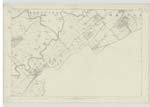OS1/25/18/32
| List of names as written | Various modes of spelling | Authorities for spelling | Situation | Description remarks |
|---|---|---|---|---|
| CISTERCIAN ABBEY (Ruin) [Coupar Angus] | Coupar Angus Abbey (Ruins of) | Mr Hawison, Coupar Angus Dr [Doctor] Lawe Sta. acct. [Statistical account] Perthshire New Sta. acct. [Statistical account] Perthshire Jervise's Memorials of Angus |
064 | [Continued from Page 31] Agricola in his 7th. expedition. It is nearly a circular square of 24 acres. Here the half of the Roman army are supposed to have encamped, while the other remained at Campmuir, a village nearly two miles south west from this place. On the centre of this Camp, Malcolm IV founded an Abbey for Cistercian Monks, A.D. 1104, and endowed it with large revenues. This house was founded by advice of the Abbott of Melrose, who was of the same order; and it is said the monks, were long remarkable for their piety and exemplary lives. From the pavement and bases of pillars, and subterraneous passages that have been discovered, this abbey appears to have been a house of considerable magnitude. Next to the Scottish Kings, the Hays of Errol were the principal benefactors to the Abbey of Coupar. The latter granted it the lands of Lidderpole, several acres of Arable land on the banks of the Tay, and liberty of fishing on that river. The Monks were allowed free passage with their cattle over all lands belonging to the house of Errol. Gilbert Hay, Constable of Scotland granted them the patronage of the church of Errol, and Chapel of Inchmartin, with all their pertinents and rights. In return for these immunities, the house of Errol claimed the privilege of burial in the Abbey. The last Abbot of Coupar was Donald Campbell of the family of Argyll. Old Statistical Account Vol [Volume] 17 pages 10 & 11. |
| ROMAN CAMP (Site of) [Coupar Angus] | 064 | The Roman Camp at Cupar Angus appears to have been a Equilateral quadrangle of 400 Yards, fortified by two strong ramparts and large ditches which still remain on the East and South sides and in part on the North side but the West side has been obliterated by the plough. Chalmers Caledonia. P. [Pages] 175. & 148. At Cupar Angus immediately behind the Churchyard there may yet be seen the Eastern rampart of a large rectangular Camp, which Maitland the Historian described about a Century ago, as being a rectangular square of about 1200 feet fortified with two strong ramparts and a double ditch. Caledonia Romana p. [page] 245. The remains of a Roman Camp are still to be seen immediately to the East of the Churchyard. The Eastern Rampart is the only one which has not been levelled. New S. Acct. [Statistical Account] In a foot note at P. [Page] 148. Chalmers remarks " This Camp seems not to have been noticed either by Gordon or by Roy" but the following passage occurs in Roy. p. [page] 133. "On the other hand if we suppose the old intrenchment within which the Abbey of Cupar in Angus is situated, to be a Roman work, and that this was the 'In Medis' of Richard." |
||
| THORN ALLEY [Coupar Angus] | David Chalmers Thomas Gardiner Mr Culross, Post Mr. [Post Master] |
064 | A name Supposedly given to a raised bank, being the "Eastern Rampart " referred to above of the Roman Camp. It is on the course of a much frequented Footpath - the sides of bank were sloping until recently, when in the economy of agriculture they have been cut steep on either side. |
Continued entries/extra info
[Page] 32Transcribers who have contributed to this page.
Bizzy- Moderator, KBMW- Moderator
Location information for this page.
Linked mapsheets.




